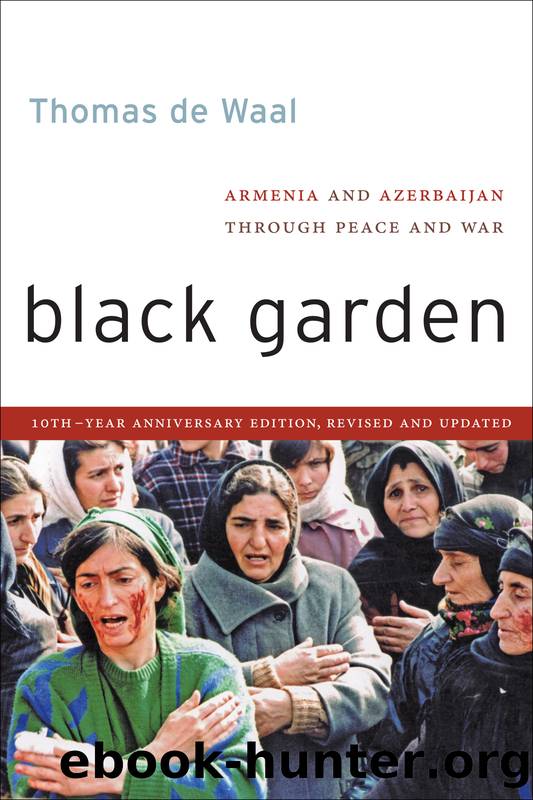Black Garden: Armenia and Azerbaijan Through Peace and War by Thomas de Waal

Author:Thomas de Waal [Waal, Thomas de]
Language: eng
Format: epub
ISBN: 9780814760321
Google: InaUxgEACAAJ
Amazon: 0814760325
Published: 2013-07-08T00:00:00+00:00
12
Shusha
The Last Citadel
On a rock above the serpentine road that twists up from Stepanakert to Shusha stands a victory memorial. It is the same T-72 tank from which Gagik Avsharian was thrown headlong in the heat of battle at midday on 8 May 1992. After the Armenians had won the war for Karabakh, they had the burned tank rebuilt, resprayed olive green, and placed on the hill with its original number, 442, repainted in white on its hull. It pointed toward Shusha.
Eight years and one day later, on 9 May 2000, Armenian Nagorny Karabakh was celebrating its Victory Day. It was marked in three stages on the way up to the citadel of Shusha, like three stations of a crusader pilgrimage, beginning with the memorial tank and ending with a service of thanksgiving in the Gazanchetsots church.
The hull of the tank had been strewn with red and white carnations, and a group of relatives were making a personal memorial. Of the three men in tank 442, only Gagik, the commander, had survived. At the rear stood Stella, the widow of Ashot, the driver, and Hovanes, his ten-year-old son. Stella looked pale, forlorn, and still absurdly young. The grandmother of Shahen, the gun operator, was wearing a black head scarf and holding a handkerchief in her clenched hand. She began to keen with grief for her lost grandson, wailing and beating the back of the tank with her fists.
Suddenly, the grieving relatives were overtaken by a brash official celebration. A brass band struck up martial tunes in the road below as a line of dignitaries climbed the steps. The Karabakhi archbishop Parkev under his arched black cowl, military officers in full uniform, and the prime minister in a gray designer suit all filed past and laid more flowers. A few minutes later, members of the brass band were running to jump on their bus. A cavalcade of cars roared toward Shusha and everyone reassembled in the lower part of the town for the next ceremony, the unveiling of a monument to a World War II fighter pilot named Nelson Stepanian.
Our final destination, the Gazanchetsots church, was, when completed in 1887, one of the largest Armenian churches in the world and a token of the success of the Shusha Armenian bourgeoisie. Closed by the Communists, it was rebuilt after 1992, clad in shiny white limestone. It now towers, immaculate once more, above the ruined town. Inside, the church was echoing and impersonal. Archbishop Parkev, looking formidable in his steep black cowl, boomed out the Armenian liturgy and the choirâs antiphons rebounded from the walls. After the commemoration of the recent war against Azerbaijan and the Great Patriotic War against the Germans, this was the final benediction, before everyone could go down to Stepanakertâs football stadium for a pop concert.
Shusha has been called the âJerusalem of Karabakh.â Whoever possesses the town controls not only a strategic fortress in the heart of the enclave but also a place saturated with history. Shusha is called, as well, the cradle of Azerbaijanâs music and poetry, the home of poets like Vagif and Natevan.
Download
This site does not store any files on its server. We only index and link to content provided by other sites. Please contact the content providers to delete copyright contents if any and email us, we'll remove relevant links or contents immediately.
| Arms Control | Diplomacy |
| Security | Trades & Tariffs |
| Treaties | African |
| Asian | Australian & Oceanian |
| Canadian | Caribbean & Latin American |
| European | Middle Eastern |
| Russian & Former Soviet Union |
The Secret History by Donna Tartt(18694)
The Social Justice Warrior Handbook by Lisa De Pasquale(12069)
Thirteen Reasons Why by Jay Asher(8716)
This Is How You Lose Her by Junot Diaz(6689)
Weapons of Math Destruction by Cathy O'Neil(6068)
Zero to One by Peter Thiel(5618)
Beartown by Fredrik Backman(5533)
The Myth of the Strong Leader by Archie Brown(5358)
The Fire Next Time by James Baldwin(5185)
How Democracies Die by Steven Levitsky & Daniel Ziblatt(5083)
Promise Me, Dad by Joe Biden(5029)
Stone's Rules by Roger Stone(4981)
100 Deadly Skills by Clint Emerson(4785)
A Higher Loyalty: Truth, Lies, and Leadership by James Comey(4768)
Rise and Kill First by Ronen Bergman(4643)
Secrecy World by Jake Bernstein(4584)
The David Icke Guide to the Global Conspiracy (and how to end it) by David Icke(4539)
The Farm by Tom Rob Smith(4397)
The Doomsday Machine by Daniel Ellsberg(4366)
